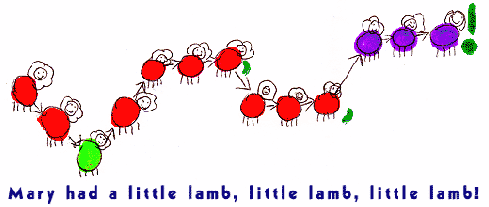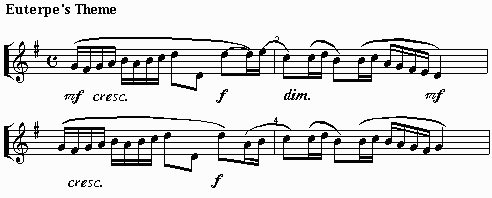


| Title: | Location | K-4 | 5-8 | 9-12 | Description | Discipline |
| Melody | SoundGarden | How is melody like a language? |
Music is a type of language that transmits ideas through sound patterns. There are many similarities with our spoken languages. For example, we use a 26 letter alphabet to construct sentences just as we use a 12 note scale to create a melody.
Like a sentence, a melody has a beginning, middle, and end. Just as we use punctuation marks (like a period) to end a sentence, we use often the first note of a musical scale to end a melody.
One other connection here is that we process all sounds in an area of our brains called the temporal lobe, right above each ear. So our perception of language and musical sound is closely related.
Write That Tune!
What do you think are some of the main aspects of melody? Listen to the following examples:
 (19") – Melody #1 - The Star Spangled Banner.
(19") – Melody #1 - The Star Spangled Banner. (13") – Melody #2 - Euterpe's SoundGarden Theme.
(13") – Melody #2 - Euterpe's SoundGarden Theme.
 (07") – Melody #3 - Schoenberg Opus 25, Mvt. V.
(07") – Melody #3 - Schoenberg Opus 25, Mvt. V.
What is your definition of melody? Write it down in your journal.
Try this:
Listen again to the examples above and imagine that they are being spoken as a language.
- First draw a picture that shows the melody's contour, or how it rises and falls in pitch. (hint: it can be abstract using lines, circles, shapes, or densities of color).
- Next, write a sentence that represents each melody. Use words that rise and fall to describe the melody's contour. (For example, if the contour is up, down, up, you might write, "When the floating bubble burst its droplets fell to the ground and splashed all around.")
- Finally, go back to your drawing of the melody. Where would you place the punctuation marks (like a comma or questions mark or period)? Mark them on your drawing.
- Has your definition of melody changed? If so, write the revised version in your journal.
Hands-On Activity – Draw That Tune!

Materials needed:
- Sketch Pad or Journal
- Colored magic markers (washable of course!)
- Your creative self
To Do:
- Pick a favorite melody that you already know (you can use one the three you've already worked with above). Play the melody on your instrument, or if you like, sing, whistle, or hum it several times.
- Next, draw a picture that represents the contour of the melody.
- Be sure to show the places where there is an emphasis placed on a pitch (you can use a darker color like purple, brown, or black to show these).
- Next, imagine that your drawing is a sentence. Where would you place the puctuation marks? Indicate on your drawing, the places where you have a pause with a comma and the ending with a period.
- Has your definition of melody changed? If so, write down the changes in your journal.
What's the Point?
Just as there can be many types of sentences in many different spoken languages, there can be different melodies. Typically we think about melody as a sucession of single pitches. If there are two or more pitches happening at the same time, we use other terms like intervals and harmony to describe them.
There are many terms associated with melody in Western music such as:
- figure
- motive
- subject
- theme
- tune

A melodic contour
There are also other qualtites to any melody. A melody usually follows a contour or shape that rises or falls in many ways. There is also an emphasis given to certain notes, either through loudness (volume change) or duration (for example a long high note).
Just for Fun!
Below are three melodies from around the world.
Listen to each one. How are they similar and different to the first three that we studied? Write a sentence that describes each melody showing its contour places of emphasis. Indicate the places where you have a pause with a comma and the ending with a period.
 (13") – Melody from Sudan, North Africa.
(13") – Melody from Sudan, North Africa. (13") – Melody from Tibet, China.
(13") – Melody from Tibet, China.
 (09") – Melody from India.
(09") – Melody from India.
"Joy is the sweet voice, joy the luminous cloud --
We in ourselves rejoice!
And thence flows all that charms our ear or sight,
All melodies the echoes of that voice,
All colors of suffusion form that light."
– Samuel Taylor Coleridge
Send your comments to: webteam@cafemuse.com
© 1996 – 2015 NewWorldView, All Rights Reserved.